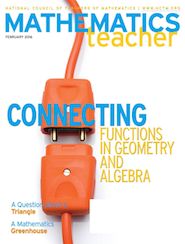Geometric Functions
With Technologically Embodied Geometric Functions, students develop conceptual metaphors that directly relate computer-based sensory motor experiences of abstract function concepts. This approach relies on four foundations:
We’re working hard to create the sketches, worksheets, and support materials for these Web Sketchpad activities. Ours is a volunteer effort on the part of everyone involved, both curriculum developers and field testers, and we make these activities freely available for you to download and use with your own students.
As we develop, revise and expand the activities, we need your help. Email your commentary (What worked well? What didn’t?) and your suggested improvements to the webmaster.
Connecting Functions in Geometry and Algebra
(Mathematics Teacher February 2016)
In this article we describe a way of forging a strong connection between geometric and algebraic functions, a connection that can deepen students’ concept of function and develop their appreciation for the interconnectedness of geometry and algebra. [from the article]
This cover story by Daniel Scher and Scott Steketee in the February 2016 Mathematics Teacher is based on our curriculum unit Connecting Geometry and Algebra Through Functions. This unit’s Web-Sketchpad-based activities connect functions in geometry (transformations whose variables are points on the plane) with functions in algebra (whose variables are points on the number line).
This is the first Mathematics Teacher article to incorporate live dynamic-mathematics figures in the online version, allowing readers to manipulate the mathematical objects in those figures as they read.
Abstract: Students work with geometric transformations as functions that take an input point and produce an output point, and relate these functions to algebra by using them to construct the Cartesian graph of a generalized linear function. They dilate and then translate a point, restrict these points to number lines, and ultimately observe that in the algebraic equation y = mx + b, m corresponds to the scale factor for dilation and b corresponds to the length of the vector for translation.
The activities described in the article are available in the Connecting Geometry and Algebra Through Functions curriculum unit.
Update History:
01 February 2016: Updated after the article appeared. 21 August 2015: Created this page.
